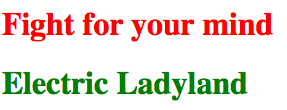XPATH and stdWrap¶
Let’s explain some basic techniques for selecting nodes from an XML source and afterwards displaying them in the FE using stdWrap. We have the following XML file:
<?xml version="1.0"?>
<collection>
<cd>
<title>Fight for your mind</title>
<artist>Ben Harper</artist>
<year>1995</year>
</cd>
<cd>
<title>Electric Ladyland</title>
<artist>Jimi Hendrix</artist>
<year>1997</year>
</cd>
</collection>
We now want to select all CD titles and display them using alternative colors. Wow, that’s a real usecase, isn’t it? ;). We decide to load the source using the FILE object within our XPATH object. The XPATH expression for selecting all title attributes within the document is simply: //title. Since the titles are atomic node values, we decide to return our result as strings. We end up with the following TypoScript:
page.10 = COA
page.10 {
10 = XPATH
10 {
source.cObject = FILE
source.cObject.file = fileadmin/xpath/collection.xml
expression = //title
return = string
}
}
We have used source’s stdWrap properties to apply a FILE object that loads the contents of our XML file from fileadmin. But wait, something is wrong, we don’t see anything on the website yet… Let’s check what’s wrong with the TSFE admin panel.

XPATH object debug output in TSFE Admin Panel
As we can see from the debug output, loading the XML data was successful but we forgot to configure a resultObj for the XPATH query. The resultObj is a key component of the XPATH object. Since each XPATH query returns an array of matches, we need an instrument to process the results. So it is a bit like using renderObj for CONTENT elements. The resultObj property works similar to the TypoScript split property and has the same subproperties. That provides us with a flexible tool for handling our results.
Let’s output the first title in red, the second in green. The resultObj for doing that looks like this:
page.10 = COA
page.10 {
10 = XPATH
10 {
source.cObject = FILE
source.cObject.file = fileadmin/xpath/collection.xml
expression = //title
return = string
resultObj {
cObjNum = 1 || 2
1.current = 1
1.wrap = <h1 style="color:red;">|</h1>
2.current = 1
2.wrap = <h1 style="color:green;">|</h1>
}
}
}
The option split determines that the first match is treated with object 1, the rest with object 2. This makes it possible to configure different wraps for our atomic node values. And here it is in all it’s beauty:

